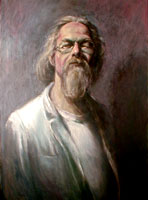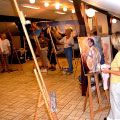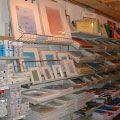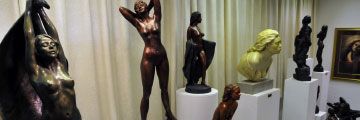
Reidar Finsrud DOB 05.03. 1946 - Born and raised in Drøbak, a small seaside town in Norway. Childhood was characterised by lively activities since the house was both a grocery shop and a telephone exchange. From the age of six his artistic talent showed itself in making everything from boats to flying saucers, painting, drawing and sculpting.
1965 Decorator with AS Elle Keramikk. Magician in spare time.
1966 Accepted as a student at Statens-Håndverk og Kunstindustriskole (Arts and Crafts),
graphic area. Built Norway’s first light organ.
1967 Graphic studies with Crix Dahl and photography with Jarle Strømme.
1968 Studied in Italy. Accepted as a member of Young Artists Society and National
Organisation for Norwegian Graphics. Debut with graphic exhibition in Oslo. Started own firm for advertising and design.
1969 Graduates from Statens-Håndverk og Kunstindustriskole with art diploma (Venezia).
Participates in an exhibition for National Organisation for Norwegian Graphics.
1970 Studied in Venice. Took part in the Spring Exhibition with "The Darkness" and
"Childhood memories". The graduate art piece is sold to the Italian Ambassador.
1971 Took part in Young Artists Society 50th anniversary exhibition and sells the first
painting to the Norwegian Culture Council. Involved in experimentation on group parapsychological abilities.
1972 Exhibition of three wooden sculptures and graphics. Plan to build a large gallery. Built
the first water scooter in Norway.
1973 Exhibition of iron sculptures and paintings. Invents "The Wild Duck of Drøbak", a
boat specially designed for spotting and catching of sea monsters. Invents the rescue carpets for cars. Local exhibition for paintings, graphic and sculptures.
1974 Experiment and lecture on mice hierarchy. With the special boat, he catches the sea monster in the Lake of Telemark.
1975 Opening of Gallery Finsrud, the largest in the Oslo region. Starts his own painting and drawing school. Paints the first large painting.
1976 Paints the series "The Way to Oslo" and exhibits the 70 paintings at his own gallery. All the paintings are sold.
1977 Exhibition of series of paintings "Vestby". The paintings were sold to state buildings. At this time he draws a new progressive system for sail boats. The technical calculations are done at Oslo University.
1978 Plan an extension to the Gallery. Experiment on prepositions allusions in the project "Bigghead". All experiments were done on ordinary people and all that saw the "phenomena" will never tell for fear of being thought mad.
1979 Makes the world’s smallest hot air balloon. This was registered as a UFO and is exhibited in Holmsbu outside Oslo.
1980 Works day and night with the extension of the Gallery. Works with the theory of why people need nicotine.
1981 The extension is finished. There is now exhibition space of 200 metres length on one wall. The opening exhibition is with Rigmor Holter. He holds a lecture on the human race decline by the use of status power. He paints the series "Spring Creek in Frogn". The gallery hosts the first art auction in the region.
1982 Marries and becomes a father for the first time. Paints landscapes on a large scale. He begins the blue period. Experiment with making full size female hitch hiking dolls placing them by the side of the road.
1983 Plans the second gallery. This will be 1100 m². Experiment with pendulum movement in magnetic fields.
1984 The art studio is moved to the new gallery.
1985 Gallery Finsrud is now the largest private gallery in Norway. This functions as a house of culture for the whole region. This accommodates film clubs, concerts, lectures. The number of visitors increases enormously. Becomes father for the second time.
1986 The workload is tiring and he has to increase his resting period to four hours per night. Painting large scale fog landscape pictures from Frogn.
1987 The second gallery is officially opened by the Mayor. Two large exhibition galleries for show and sale exhibitions. They also contain teaching studios, graphic workshops and also paint and sculpture workshops. Finsrud paints autumn landscapes and large paintings from Telemark.
1988 The painting school now has 120 students per year and he starts a pilot project that later becomes the female series 1990-2000 and paints large winter landscapes for the City Hall of Drøbak. Due to time and money pressures, he closes one gallery and is able to concentrate his efforts towards his own work.
1989 Begins series of paintings of women in charcoal and paints a series of landscapes in oils with pastel colours. Invents a speaking and fencing santa claus in full size model.
1990 Begins full project for the 1999-2000 series. This includes drawings, paintings and sculptures. He is the main sponsor for the Norwegian-Swedish Greenland expedition with graphic "Towards the Unknown Land". Experiment with new methods and materials for sculpting. Awarded many contracts.
1991 Activity increases in all areas. Two major works are painted with the Viking Times as the theme. "Over the Mountain" and "Steel of the Sword" both sized 170 x 370 make up part of this collection. "Quiet Day in January" painted and is used by UNICEF as postcards worldwide. Large series of graphics for two Norwegian publishers, Cappelen and Ford Norway.
1992 Discards all ideas for the two dimensional solution concerning "free energy machines" (Perpetuum mobile). Begins to use in his teaching his theory on the brain’s "drawing hostility" centre.
1993 Makes a new automatic graphic stamp. Specialists claim that this is impossible but after three months it works with great precision. Thus it is proven that extremely complicated machines can be made on the worktop in the kitchen. "The Future House" is drawn to last for hundreds of years with minimum amounts of energy required. Begins work on the painting "Blucher" sized 200 x 400 cm and "Elliptical Composition" also sized 200 x 400 cm. "Winter in Telemark" is used by UNICEF as postcards and sold by the millions. Documentary filmed by German company on the Blucher painting.
1994 Presentation of the first Phenisaurus sculptures in connection with the Olympic Games at Lillehammer.
1995 The possibility of maintaining mechanical movement over a longer period of time in his four dimensional machine experiments is considered. Self portrait created as a life size doll which is placed in the window of the gallery and lit – people think he is working day and night.
1996 Perpetuum mobile is presented to the public after a successful start and it is shown on the main news on all the major TV channels. The principle behind this machine is described in "New Energy News" in the United States and "Deutsche Physik". Begins new sculpting project called "Mermaids" and installed at the harbour in Drøbak. MTV produces a film about him entitled "The Art of the Impossible".
1997 Sculptures "Nina II" and "Hanne" completed. MTV film completed and sold to England, Sweden, Denmark and Norwegian TV.
1998 Participates in the competition of the making of the altar painting in Frogn Church. Expansion of the female series with five new sculptures and more contracts awarded for production of art work for State buildings.
1999 All sculptures from the female series exhibited. Exhibition receives enormous press coverage and large TV companies from all over the world film the exhibition. "Mermaids" are installed at Drøbak harbour. Sculpture "Dorthe" is installed in the shopping centre Steen & Strøm, Vinterbro. One of the shopping streets is named after him, Reidar Finsruds Avenue. New projected started "Sun Dial 2000". This is a 2 metres in height thermo-technical construction. This receives its mobile energy from the sun. "Fønvind" sculpture is created.

















